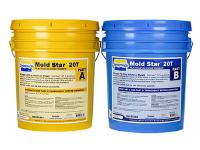Mold Star™ 20T /36 kg
Mold Star™ 20T is an easy to use Shore 20A translucent platinum silicone that is mixed 1A:1B by volume (no weighing scale necessary). It features a relatively low viscosity and vacuum degassing is not required for most applications. Pot life is 6 minutes and cure time is 30 minutes at room temperature.
Features
Mold Star™ 20T cures in to a soft, strong rubber that is tear resistant and exhibits very low long term shrinkage. Molds made with Mold Star™ will last a long time in your mold library and are good for casting wax, gypsum, resins, and other materials. An infinite number of color effects can be achieved by adding Silc Pig™ silicone pigments or Cast Magic™ effects powders.
Mold Star™ 20T is heat resistant up to 232°C and is suitable for casting low-temperature melt metal alloys.
Cured Mold Star™ 19T, 20T and 31T silicones have been tested and certified skin safe by an independent laboratory.
Note: This product will not cure against surfaces containing sulfur, even when sealed.
Mix Ratio By Weight & Volume 1A:1B - Specific Volume 25.6 cu. in./lb - Color Translucent - Shore Hardness 20 A - Elongation @ Break 740 %
|
|
Safety - Use in a properly ventilated area (“room size” ventilation). Wear safety glasses, long sleeves and rubber gloves to minimize contamination risk. Wear vinyl gloves only. Latex gloves will inhibit the cure of the rubber.
Store and use material at room temperature 23°C. Warmer temperatures will drastically reduce working time and cure time. Storing material at warmer temperatures will also reduce the usable shelf life of unused material. These products have a limited shelf life and should be used as soon as possible.
Cure Inhibition - Addition cured silicone rubber may be inhibited by certain contaminants in or on the pattern to be molded resulting in tackiness at the pattern interface or a total lack of cure throughout the mold. Latex, sulfur clays, certain wood surfaces, newly cast polyester, epoxy or urethane rubber my cause inhibition. If compatibility between the rubber and the surface is a concern, a small-scale test is recommended. Apply a small amount of rubber onto a non-critical area of the pattern. Inhibition has occurred if the rubber is gummy or uncured after the recommended cure time has passed. To prevent inhibition, one or more coatings of a clear acrylic lacquer applied to the model surface is usually effective. Allow any sealer to thoroughly dry before applying rubber.
Even with a sealer, Mold Star™ 20T will not cure against surfaces containing sulfur. If you are not sure if your clay contains sulfur, do a small compatibility test before using for an important project.
Applying A Release Agent - Although not usually necessary, a release agent will make demolding easier when casting into most surfaces. Ease Release™ 200 is a proven release agent for releasing silicone from silicone or other surfaces. Mann Ease Release™ products are available from Form X
Because no two applications are quite the same, a small test application to determine suitability for your project is recommended if performance of this material is in question.
Measuring & Mixing - Before you begin, pre-mix Part A and Part B separately. After dispensing required amounts of Parts A and B into mixing container (1A:1B by volume or weight), mix thoroughly making sure that you scrape the sides and bottom of the mixing container several times.
Optional... Vacuum Degassing - Although not necessary, vacuum degassing helps eliminate any entrapped air in pourable silicone rubber. After mixing parts A and B, vacuum material for 2-3 minutes at 29 inches of mercury, making sure that you leave enough room in container for product expansion.
Pouring - For best results, pour your mixture in a single spot at the lowest point of the containment field. Let the rubber seek its own level. A uniform flow will help minimize entrapped air. If using as a mold material, the liquid rubber should level off at least 1.3 cm over the highest point of the model surface.
Curing - Allow mold rubber to cure for 30 minutes at room temperature 23°C before demolding.
Heat Curing - Time to demold can be reduced with mild heat. Example: After pouring Mold Star™ 20T at room temperature, place the mold in a hot box or industrial oven at 60°C. This may reduce the demold time substantially. Note - time will vary depending on mold thickness.
Making a Brush On Mold? - Mold Star™ 20T silicone can be thickened with THI-VEX™ thickener for brush-on application and effects. Do not use other Mold Star™ Series silicones for brush on mold making.
Mold Performance & Storage - The physical life of the mold depends on how you use it (materials cast, frequency, etc.). Casting abrasive materials can quickly erode mold detail, while casting non-abrasive materials (wax) will not affect mold detail. Before storing, the mold should be cleaned with a soap solution and wiped fully dry. Two part (or more) molds should be assembled. Molds should be stored on a level surface in a cool, dry environment.
